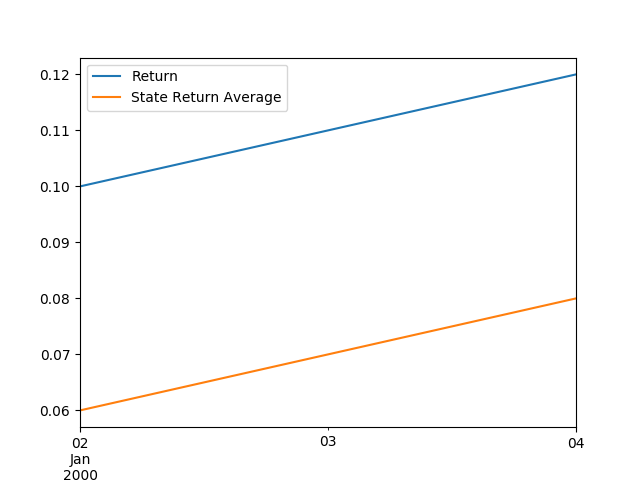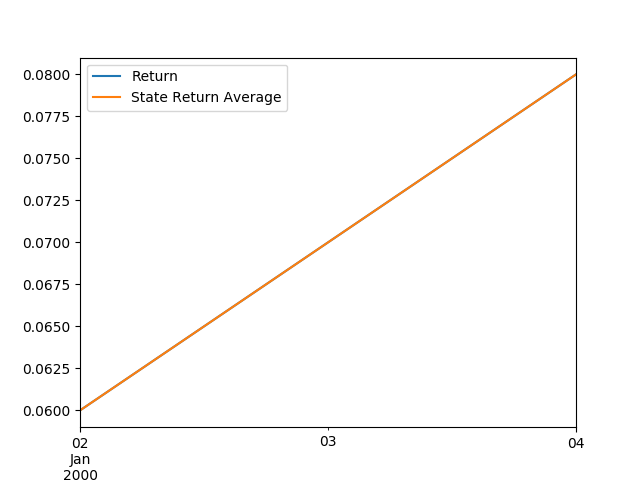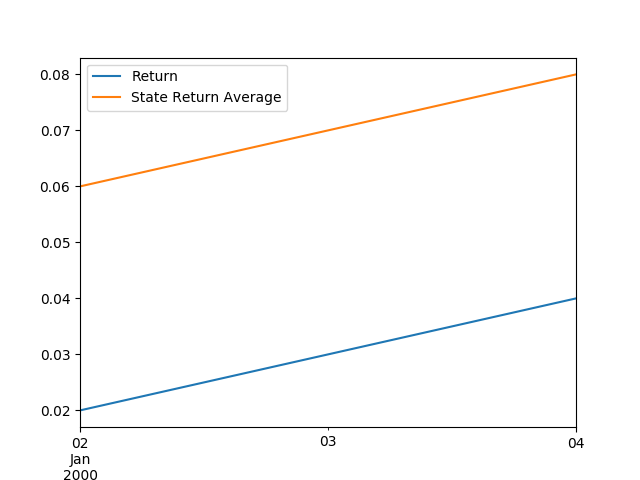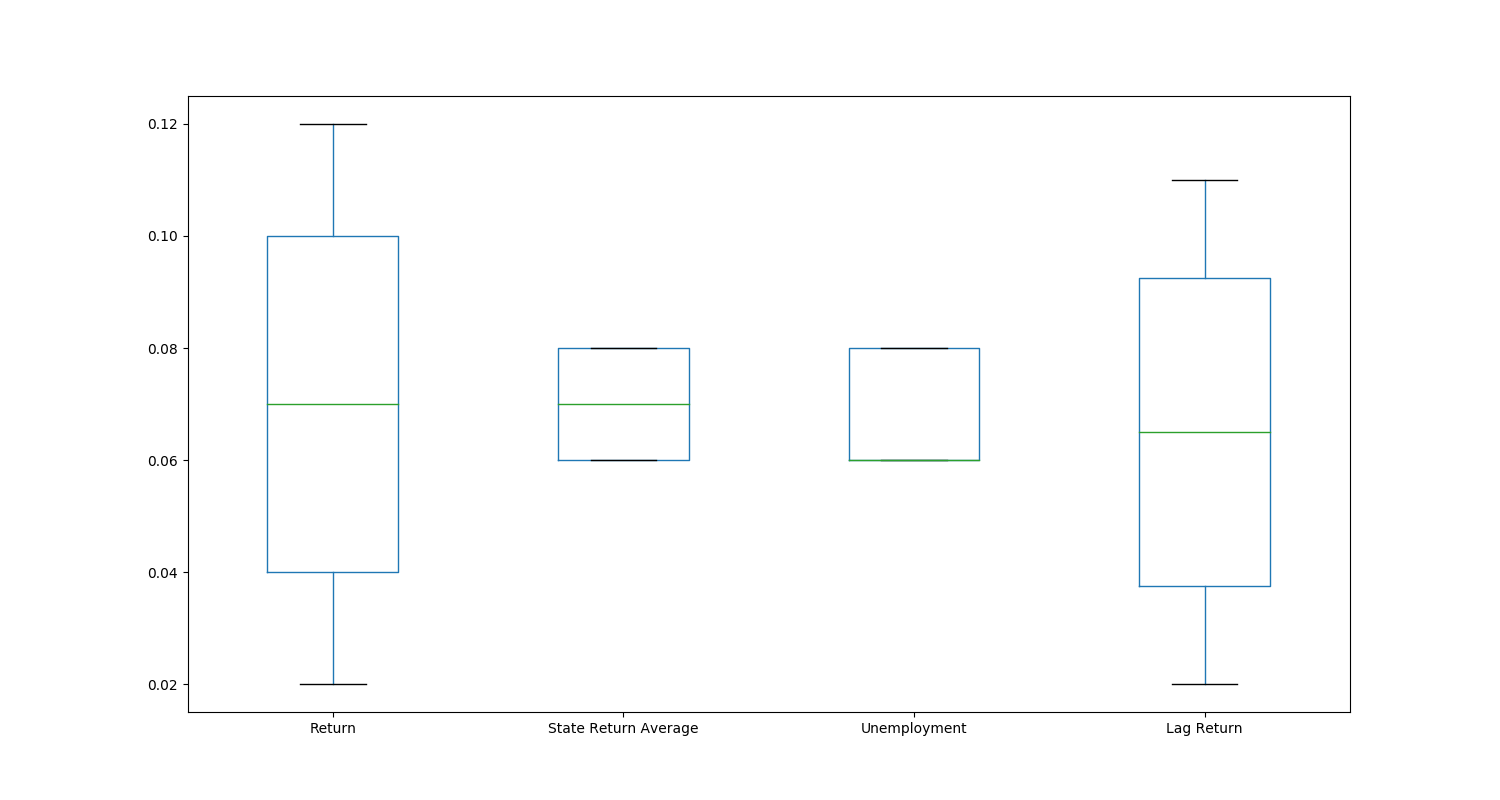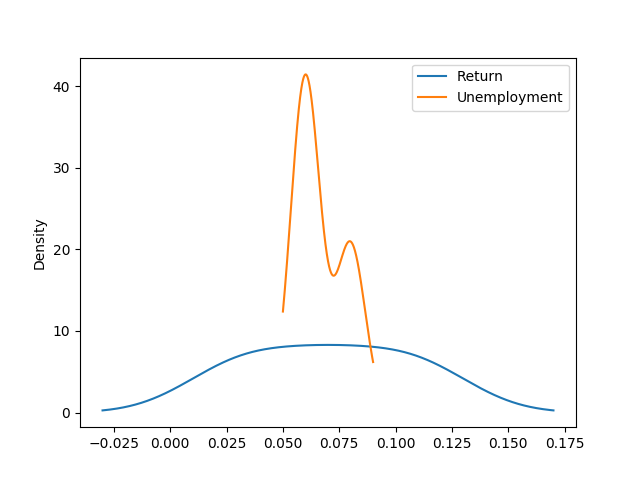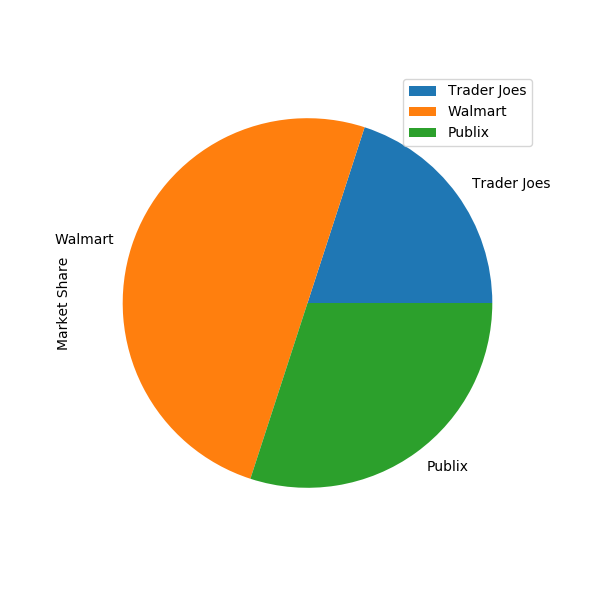Note
Click here to download the full example code or to run this example in your browser via Binder
Data Management in Python Using Standard Tooling¶
Prior to beginning the tutorial, please install the following packages
via pip:
pandas
matplotlib
statsmodels
seaborn
openpyxl
xlrd
Note: if you’re using Anaconda, some of these will be installed already.
Note: if you’re running the example in Binder, no installation is necessary
Overview¶
pandas is a large library which includes a data structure called a
DataFrame which is originally based on R’s data.frame. In
Python, it is built on top of the array datatype in the similarly
popular numpy library. Each column in a DataFrame is a
pandas Series.
I use numpy for some specific functions or when I need higher
performance than pandas, but pandas is much more convenient to
use.
Here is what we’re going to cover:
Give me a DataFrame!¶
A DataFrame can be created in many ways, including: - From a csv
or Excel file - From a SAS7BDAT (SAS data) or dta (Stata data)
file - From other Python data structures (list of tuples, dictionaries,
numpy arrays)
Here I will create an example DataFrame from a list of tuples. At
the end I will show loading and writing to files.
import pandas as pd #this is the convention for importing pandas, then you can use pd. for functions
df = pd.DataFrame(
data=[
('Walmart', 'FL', '1/2/2000', .02),
('Walmart', 'FL', '1/3/2000', .03),
('Walmart', 'FL', '1/4/2000', .04),
('Trader Joes', 'GA', '1/2/2000', .06),
('Trader Joes', 'GA', '1/3/2000', .07),
('Trader Joes', 'GA', '1/4/2000', .08),
('Publix', 'FL', '1/2/2000', .1),
('Publix', 'FL', '1/3/2000', .11),
('Publix', 'FL', '1/4/2000', .12),
],
columns = ['Company', 'State', 'Date', 'Return']
)
pandas combined with Jupyter gives you a nice representation of your
data by simply typing the name of the variable storing your
DataFrame:
df
| Company | State | Date | Return | |
|---|---|---|---|---|
| 0 | Walmart | FL | 1/2/2000 | 0.02 |
| 1 | Walmart | FL | 1/3/2000 | 0.03 |
| 2 | Walmart | FL | 1/4/2000 | 0.04 |
| 3 | Trader Joes | GA | 1/2/2000 | 0.06 |
| 4 | Trader Joes | GA | 1/3/2000 | 0.07 |
| 5 | Trader Joes | GA | 1/4/2000 | 0.08 |
| 6 | Publix | FL | 1/2/2000 | 0.10 |
| 7 | Publix | FL | 1/3/2000 | 0.11 |
| 8 | Publix | FL | 1/4/2000 | 0.12 |
Working with Data in Pandas¶
One of the DataFrames greatest strengths is how flexibly they can
be split, combined, and aggregated.
Selecting Data¶
df[df['State'] == 'FL'] # read: dataframe where the dataframe column 'state' is 'FL'
df.iloc[1:3] # give me the second through the third rows
df.iloc[:, 2] # all rows for the third column (looks different because it's a Series)
df['Company'] # company column (Series)
best_grocery_stores = ['Trader Joes', 'Publix']
# only rows where company is in the best grocery stores and has a high return,
# but also give me only the company and return columns
df.loc[df['Company'].isin(best_grocery_stores) & (df['Return'] > 0.07), ['Company', 'Return']]
| Company | Return | |
|---|---|---|
| 5 | Trader Joes | 0.08 |
| 6 | Publix | 0.10 |
| 7 | Publix | 0.11 |
| 8 | Publix | 0.12 |
Aggregating¶
DataFrames have a .groupby which works similarly to group by
in a SQL (proc SQL) command.
df.groupby('Company')
Out:
<pandas.core.groupby.generic.DataFrameGroupBy object at 0x7f27a2dd8fd0>
To make it useful, we must aggregate the data somehow:
df.groupby(['State','Date']).mean() #also .median, .std, .count
| Return | ||
|---|---|---|
| State | Date | |
| FL | 1/2/2000 | 0.06 |
| 1/3/2000 | 0.07 | |
| 1/4/2000 | 0.08 | |
| GA | 1/2/2000 | 0.06 |
| 1/3/2000 | 0.07 | |
| 1/4/2000 | 0.08 |
Note that there the index becomes the groupby columns. If we want keep
the columns in the DataFrame, pass as_index=False.
df.groupby(['State','Date'], as_index=False).mean() #also .median, .std, .count
| State | Date | Return | |
|---|---|---|---|
| 0 | FL | 1/2/2000 | 0.06 |
| 1 | FL | 1/3/2000 | 0.07 |
| 2 | FL | 1/4/2000 | 0.08 |
| 3 | GA | 1/2/2000 | 0.06 |
| 4 | GA | 1/3/2000 | 0.07 |
| 5 | GA | 1/4/2000 | 0.08 |
Note that the shape of the data when using plain groupby is whatever the
shape of the unique values of the groupby columns. If instead we want to
add a column to our DataFrame representing the aggregated values,
use .transform on top of groupby.
This example also shows how to assign a new column to a DataFrame.
df['State Return Average'] = df.groupby(['State','Date']).transform('mean')
df
| Company | State | Date | Return | State Return Average | |
|---|---|---|---|---|---|
| 0 | Walmart | FL | 1/2/2000 | 0.02 | 0.06 |
| 1 | Walmart | FL | 1/3/2000 | 0.03 | 0.07 |
| 2 | Walmart | FL | 1/4/2000 | 0.04 | 0.08 |
| 3 | Trader Joes | GA | 1/2/2000 | 0.06 | 0.06 |
| 4 | Trader Joes | GA | 1/3/2000 | 0.07 | 0.07 |
| 5 | Trader Joes | GA | 1/4/2000 | 0.08 | 0.08 |
| 6 | Publix | FL | 1/2/2000 | 0.10 | 0.06 |
| 7 | Publix | FL | 1/3/2000 | 0.11 | 0.07 |
| 8 | Publix | FL | 1/4/2000 | 0.12 | 0.08 |
Columns can be combined with basic math operations
df['Ratio'] = df['Return'] / df['State Return Average']
df
| Company | State | Date | Return | State Return Average | Ratio | |
|---|---|---|---|---|---|---|
| 0 | Walmart | FL | 1/2/2000 | 0.02 | 0.06 | 0.333333 |
| 1 | Walmart | FL | 1/3/2000 | 0.03 | 0.07 | 0.428571 |
| 2 | Walmart | FL | 1/4/2000 | 0.04 | 0.08 | 0.500000 |
| 3 | Trader Joes | GA | 1/2/2000 | 0.06 | 0.06 | 1.000000 |
| 4 | Trader Joes | GA | 1/3/2000 | 0.07 | 0.07 | 1.000000 |
| 5 | Trader Joes | GA | 1/4/2000 | 0.08 | 0.08 | 1.000000 |
| 6 | Publix | FL | 1/2/2000 | 0.10 | 0.06 | 1.666667 |
| 7 | Publix | FL | 1/3/2000 | 0.11 | 0.07 | 1.571429 |
| 8 | Publix | FL | 1/4/2000 | 0.12 | 0.08 | 1.500000 |
Functions can be applied to columns or the entire DataFrame:
import numpy as np # convention for importing numpy.
def sort_ratios(value):
# If the value is missing or is not a number, return as is
# Without this, the function will error out as soon as it hits either of those
if pd.isnull(value) or not isinstance(value, np.float):
return value
# Otherwise, sort into categories based on the value
if value == 1:
return 'Even'
if value < 1:
return 'Low'
if value >= 1:
return 'High'
df['Ratio Size'] = df['Ratio'].apply(sort_ratios) # apply function to ratio column, save result as ratio size column
df
df.applymap(sort_ratios) # apply function to all values in df, but only display and don't save back to df
| Company | State | Date | Return | State Return Average | Ratio | Ratio Size | |
|---|---|---|---|---|---|---|---|
| 0 | Walmart | FL | 1/2/2000 | Low | Low | Low | Low |
| 1 | Walmart | FL | 1/3/2000 | Low | Low | Low | Low |
| 2 | Walmart | FL | 1/4/2000 | Low | Low | Low | Low |
| 3 | Trader Joes | GA | 1/2/2000 | Low | Low | Even | Even |
| 4 | Trader Joes | GA | 1/3/2000 | Low | Low | Even | Even |
| 5 | Trader Joes | GA | 1/4/2000 | Low | Low | Even | Even |
| 6 | Publix | FL | 1/2/2000 | Low | Low | High | High |
| 7 | Publix | FL | 1/3/2000 | Low | Low | High | High |
| 8 | Publix | FL | 1/4/2000 | Low | Low | High | High |
Merging¶
See here for more details.
Let’s create a DataFrame containing information on employment rates
in the various states and merge it to this dataset.
employment_df = pd.DataFrame(
data=[
('FL', 0.06),
('GA', 0.08),
('PA', 0.07)
],
columns=['State', 'Unemployment']
)
employment_df
df = df.merge(employment_df, how='left', on='State')
df
| Company | State | Date | Return | State Return Average | Ratio | Ratio Size | Unemployment | |
|---|---|---|---|---|---|---|---|---|
| 0 | Walmart | FL | 1/2/2000 | 0.02 | 0.06 | 0.333333 | Low | 0.06 |
| 1 | Walmart | FL | 1/3/2000 | 0.03 | 0.07 | 0.428571 | Low | 0.06 |
| 2 | Walmart | FL | 1/4/2000 | 0.04 | 0.08 | 0.500000 | Low | 0.06 |
| 3 | Trader Joes | GA | 1/2/2000 | 0.06 | 0.06 | 1.000000 | Even | 0.08 |
| 4 | Trader Joes | GA | 1/3/2000 | 0.07 | 0.07 | 1.000000 | Even | 0.08 |
| 5 | Trader Joes | GA | 1/4/2000 | 0.08 | 0.08 | 1.000000 | Even | 0.08 |
| 6 | Publix | FL | 1/2/2000 | 0.10 | 0.06 | 1.666667 | High | 0.06 |
| 7 | Publix | FL | 1/3/2000 | 0.11 | 0.07 | 1.571429 | High | 0.06 |
| 8 | Publix | FL | 1/4/2000 | 0.12 | 0.08 | 1.500000 | High | 0.06 |
Appending is similarly simple. Here I will append a slightly modified
DataFrame to itself:
copy_df = df.copy()
copy_df['Extra Column'] = 5
copy_df.drop('Ratio Size', axis=1, inplace=True) # inplace=True means it gets dropped in the existing DataFrame
df.append(copy_df)
| Company | State | Date | Return | State Return Average | Ratio | Ratio Size | Unemployment | Extra Column | |
|---|---|---|---|---|---|---|---|---|---|
| 0 | Walmart | FL | 1/2/2000 | 0.02 | 0.06 | 0.333333 | Low | 0.06 | NaN |
| 1 | Walmart | FL | 1/3/2000 | 0.03 | 0.07 | 0.428571 | Low | 0.06 | NaN |
| 2 | Walmart | FL | 1/4/2000 | 0.04 | 0.08 | 0.500000 | Low | 0.06 | NaN |
| 3 | Trader Joes | GA | 1/2/2000 | 0.06 | 0.06 | 1.000000 | Even | 0.08 | NaN |
| 4 | Trader Joes | GA | 1/3/2000 | 0.07 | 0.07 | 1.000000 | Even | 0.08 | NaN |
| 5 | Trader Joes | GA | 1/4/2000 | 0.08 | 0.08 | 1.000000 | Even | 0.08 | NaN |
| 6 | Publix | FL | 1/2/2000 | 0.10 | 0.06 | 1.666667 | High | 0.06 | NaN |
| 7 | Publix | FL | 1/3/2000 | 0.11 | 0.07 | 1.571429 | High | 0.06 | NaN |
| 8 | Publix | FL | 1/4/2000 | 0.12 | 0.08 | 1.500000 | High | 0.06 | NaN |
| 0 | Walmart | FL | 1/2/2000 | 0.02 | 0.06 | 0.333333 | NaN | 0.06 | 5.0 |
| 1 | Walmart | FL | 1/3/2000 | 0.03 | 0.07 | 0.428571 | NaN | 0.06 | 5.0 |
| 2 | Walmart | FL | 1/4/2000 | 0.04 | 0.08 | 0.500000 | NaN | 0.06 | 5.0 |
| 3 | Trader Joes | GA | 1/2/2000 | 0.06 | 0.06 | 1.000000 | NaN | 0.08 | 5.0 |
| 4 | Trader Joes | GA | 1/3/2000 | 0.07 | 0.07 | 1.000000 | NaN | 0.08 | 5.0 |
| 5 | Trader Joes | GA | 1/4/2000 | 0.08 | 0.08 | 1.000000 | NaN | 0.08 | 5.0 |
| 6 | Publix | FL | 1/2/2000 | 0.10 | 0.06 | 1.666667 | NaN | 0.06 | 5.0 |
| 7 | Publix | FL | 1/3/2000 | 0.11 | 0.07 | 1.571429 | NaN | 0.06 | 5.0 |
| 8 | Publix | FL | 1/4/2000 | 0.12 | 0.08 | 1.500000 | NaN | 0.06 | 5.0 |
We can append to the side as well! (concatenate)
temp_df = pd.concat([df, copy_df], axis=1)
temp_df
| Company | State | Date | Return | State Return Average | Ratio | Ratio Size | Unemployment | Company | State | Date | Return | State Return Average | Ratio | Unemployment | Extra Column | |
|---|---|---|---|---|---|---|---|---|---|---|---|---|---|---|---|---|
| 0 | Walmart | FL | 1/2/2000 | 0.02 | 0.06 | 0.333333 | Low | 0.06 | Walmart | FL | 1/2/2000 | 0.02 | 0.06 | 0.333333 | 0.06 | 5 |
| 1 | Walmart | FL | 1/3/2000 | 0.03 | 0.07 | 0.428571 | Low | 0.06 | Walmart | FL | 1/3/2000 | 0.03 | 0.07 | 0.428571 | 0.06 | 5 |
| 2 | Walmart | FL | 1/4/2000 | 0.04 | 0.08 | 0.500000 | Low | 0.06 | Walmart | FL | 1/4/2000 | 0.04 | 0.08 | 0.500000 | 0.06 | 5 |
| 3 | Trader Joes | GA | 1/2/2000 | 0.06 | 0.06 | 1.000000 | Even | 0.08 | Trader Joes | GA | 1/2/2000 | 0.06 | 0.06 | 1.000000 | 0.08 | 5 |
| 4 | Trader Joes | GA | 1/3/2000 | 0.07 | 0.07 | 1.000000 | Even | 0.08 | Trader Joes | GA | 1/3/2000 | 0.07 | 0.07 | 1.000000 | 0.08 | 5 |
| 5 | Trader Joes | GA | 1/4/2000 | 0.08 | 0.08 | 1.000000 | Even | 0.08 | Trader Joes | GA | 1/4/2000 | 0.08 | 0.08 | 1.000000 | 0.08 | 5 |
| 6 | Publix | FL | 1/2/2000 | 0.10 | 0.06 | 1.666667 | High | 0.06 | Publix | FL | 1/2/2000 | 0.10 | 0.06 | 1.666667 | 0.06 | 5 |
| 7 | Publix | FL | 1/3/2000 | 0.11 | 0.07 | 1.571429 | High | 0.06 | Publix | FL | 1/3/2000 | 0.11 | 0.07 | 1.571429 | 0.06 | 5 |
| 8 | Publix | FL | 1/4/2000 | 0.12 | 0.08 | 1.500000 | High | 0.06 | Publix | FL | 1/4/2000 | 0.12 | 0.08 | 1.500000 | 0.06 | 5 |
Be careful, pandas allows you to have multiple columns with the same
name (generally a bad idea):
temp_df['Unemployment']
| Unemployment | Unemployment | |
|---|---|---|
| 0 | 0.06 | 0.06 |
| 1 | 0.06 | 0.06 |
| 2 | 0.06 | 0.06 |
| 3 | 0.08 | 0.08 |
| 4 | 0.08 | 0.08 |
| 5 | 0.08 | 0.08 |
| 6 | 0.06 | 0.06 |
| 7 | 0.06 | 0.06 |
| 8 | 0.06 | 0.06 |
Time series¶
See here for more details.
Lagging¶
Lags are easy with pandas. The number in shift below represents the
number of rows to lag.
df.sort_values(['Company', 'Date'], inplace=True)
df['Lag Return'] = df['Return'].shift(1)
df
| Company | State | Date | Return | State Return Average | Ratio | Ratio Size | Unemployment | Lag Return | |
|---|---|---|---|---|---|---|---|---|---|
| 6 | Publix | FL | 1/2/2000 | 0.10 | 0.06 | 1.666667 | High | 0.06 | NaN |
| 7 | Publix | FL | 1/3/2000 | 0.11 | 0.07 | 1.571429 | High | 0.06 | 0.10 |
| 8 | Publix | FL | 1/4/2000 | 0.12 | 0.08 | 1.500000 | High | 0.06 | 0.11 |
| 3 | Trader Joes | GA | 1/2/2000 | 0.06 | 0.06 | 1.000000 | Even | 0.08 | 0.12 |
| 4 | Trader Joes | GA | 1/3/2000 | 0.07 | 0.07 | 1.000000 | Even | 0.08 | 0.06 |
| 5 | Trader Joes | GA | 1/4/2000 | 0.08 | 0.08 | 1.000000 | Even | 0.08 | 0.07 |
| 0 | Walmart | FL | 1/2/2000 | 0.02 | 0.06 | 0.333333 | Low | 0.06 | 0.08 |
| 1 | Walmart | FL | 1/3/2000 | 0.03 | 0.07 | 0.428571 | Low | 0.06 | 0.02 |
| 2 | Walmart | FL | 1/4/2000 | 0.04 | 0.08 | 0.500000 | Low | 0.06 | 0.03 |
But really we want the lagged value to come from the same firm:
df['Lag Return'] = df.groupby('Company')['Return'].shift(1)
df
| Company | State | Date | Return | State Return Average | Ratio | Ratio Size | Unemployment | Lag Return | |
|---|---|---|---|---|---|---|---|---|---|
| 6 | Publix | FL | 1/2/2000 | 0.10 | 0.06 | 1.666667 | High | 0.06 | NaN |
| 7 | Publix | FL | 1/3/2000 | 0.11 | 0.07 | 1.571429 | High | 0.06 | 0.10 |
| 8 | Publix | FL | 1/4/2000 | 0.12 | 0.08 | 1.500000 | High | 0.06 | 0.11 |
| 3 | Trader Joes | GA | 1/2/2000 | 0.06 | 0.06 | 1.000000 | Even | 0.08 | NaN |
| 4 | Trader Joes | GA | 1/3/2000 | 0.07 | 0.07 | 1.000000 | Even | 0.08 | 0.06 |
| 5 | Trader Joes | GA | 1/4/2000 | 0.08 | 0.08 | 1.000000 | Even | 0.08 | 0.07 |
| 0 | Walmart | FL | 1/2/2000 | 0.02 | 0.06 | 0.333333 | Low | 0.06 | NaN |
| 1 | Walmart | FL | 1/3/2000 | 0.03 | 0.07 | 0.428571 | Low | 0.06 | 0.02 |
| 2 | Walmart | FL | 1/4/2000 | 0.04 | 0.08 | 0.500000 | Low | 0.06 | 0.03 |
Things get slightly more complicated if you want to take into account
missing dates within a firm. Then you must fill the DataFrame with
missing data for those excluded dates, then run the above function, then
drop those missing rows. A bit too much for this tutorial, but I have
code available for this upon request.
Resampling¶
pandas has a lot of convenient methods for changing the frequency of
the data.
Here I will create a df containing intraday returns for the three companies
import datetime
from itertools import product
firms = df['Company'].unique().tolist() # list of companies in df
dates = df['Date'].unique().tolist() # list of dates in df
num_periods_per_day = 13 #30 minute intervals
combos = product(firms, dates, [i+1 for i in range(num_periods_per_day)]) # all combinations of company, date, and period number
data_tuples = [
(
combo[0], # company
datetime.datetime.strptime(combo[1], '%m/%d/%Y') + datetime.timedelta(hours=9.5, minutes=30 * combo[2]), #datetime
np.random.rand() * 100 # price
)
for combo in combos
]
intraday_df = pd.DataFrame(data_tuples, columns=['Company', 'Datetime', 'Price'])
intraday_df.head() # now the df is quite long, so we can use df.head() and df.tail() to see beginning and end of df
| Company | Datetime | Price | |
|---|---|---|---|
| 0 | Publix | 2000-01-02 10:00:00 | 25.250127 |
| 1 | Publix | 2000-01-02 10:30:00 | 78.297648 |
| 2 | Publix | 2000-01-02 11:00:00 | 18.903450 |
| 3 | Publix | 2000-01-02 11:30:00 | 42.139811 |
| 4 | Publix | 2000-01-02 12:00:00 | 53.523835 |
First must set the date variable as the index to do resampling
intraday_df.set_index('Datetime', inplace=True)
Now we can resample to aggregate:
intraday_df.groupby('Company').resample('1D').mean()
| Price | ||
|---|---|---|
| Company | Datetime | |
| Publix | 2000-01-02 | 51.581870 |
| 2000-01-03 | 49.985571 | |
| 2000-01-04 | 49.441363 | |
| Trader Joes | 2000-01-02 | 44.736422 |
| 2000-01-03 | 59.731791 | |
| 2000-01-04 | 38.360582 | |
| Walmart | 2000-01-02 | 65.725321 |
| 2000-01-03 | 50.844221 | |
| 2000-01-04 | 42.806827 |
Or we can increase the frequency of the data, using bfill to
backward fill or ffill to forward fill. Here I specify to backward
fill but only go back one period at most.
intraday_df.groupby('Company').resample('10min').bfill(limit=1).head(10)
| Company | Price | ||
|---|---|---|---|
| Company | Datetime | ||
| Publix | 2000-01-02 10:00:00 | Publix | 25.250127 |
| 2000-01-02 10:10:00 | NaN | NaN | |
| 2000-01-02 10:20:00 | Publix | 78.297648 | |
| 2000-01-02 10:30:00 | Publix | 78.297648 | |
| 2000-01-02 10:40:00 | NaN | NaN | |
| 2000-01-02 10:50:00 | Publix | 18.903450 | |
| 2000-01-02 11:00:00 | Publix | 18.903450 | |
| 2000-01-02 11:10:00 | NaN | NaN | |
| 2000-01-02 11:20:00 | Publix | 42.139811 | |
| 2000-01-02 11:30:00 | Publix | 42.139811 |
Plotting¶
Oh yeah, we’ve got graphs too. pandas’ plotting functionality is
built on top of the popular matplotlib library, which is a graphing
library based on MATLAB’s graphing functionality.
# we've got to run this magic once per session if we want graphics to show up in the notebook
# %matplotlib inline
pandas tries to guess what you want to plot. By default it will put
each numeric column as a y variable and the index as the x variable.
df.plot()
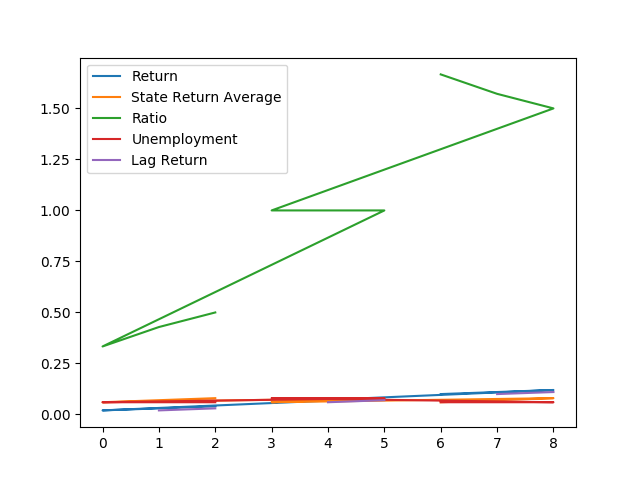
Out:
<matplotlib.axes._subplots.AxesSubplot object at 0x7f27a2a72690>
But we can tell it specifically what we want to do. Maybe we want one plot for each company showing only how the company return moves relative to the state average return over time.
df
df['Date'] = pd.to_datetime(df['Date']) # convert date from string type to datetime type
df.groupby('Company').plot(y=['Return', 'State Return Average'], x='Date')
Out:
Company
Publix AxesSubplot(0.125,0.11;0.775x0.77)
Trader Joes AxesSubplot(0.125,0.11;0.775x0.77)
Walmart AxesSubplot(0.125,0.11;0.775x0.77)
dtype: object
pandas exposes most of the plots in matplotlib. Supported types
include: - ‘line’ : line plot (default) - ‘bar’ : vertical bar plot -
‘barh’ : horizontal bar plot - ‘hist’ : histogram - ‘box’ : boxplot -
‘kde’ : Kernel Density Estimation plot - ‘density’ : same as ‘kde’ -
‘area’ : area plot - ‘pie’ : pie plot - ‘scatter’ : scatter plot -
‘hexbin’ : hexbin plot
df.drop('Ratio', axis=1).plot(kind='box', figsize=(15,8))
df.plot(y=['Return', 'Unemployment'], kind='kde')
market_share_df = pd.DataFrame(
data=[
('Trader Joes', .2),
('Walmart', .5),
('Publix', .3)
],
columns=['Company', 'Market Share']
).set_index('Company')
market_share_df.plot(y='Market Share', kind='pie', figsize=(6,6))
Out:
<matplotlib.axes._subplots.AxesSubplot object at 0x7f2798ad9a50>
Check out the seaborn package for some cool high level plotting
capabilities.
import seaborn as sns # convention for importing seaborn
sns.pairplot(df[['Company', 'Return', 'State Return Average']], hue='Company')
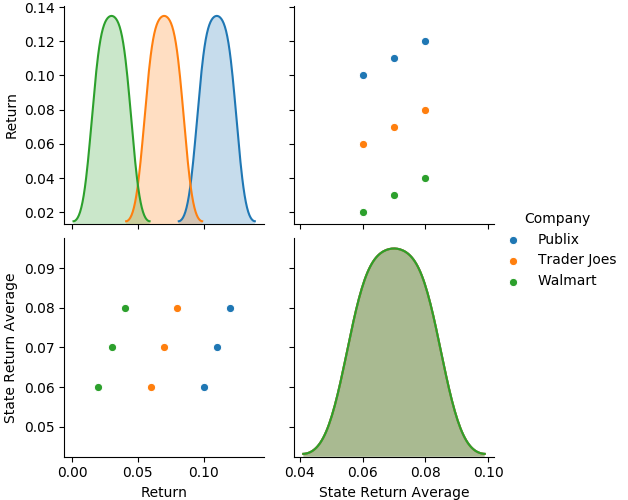
Out:
<seaborn.axisgrid.PairGrid object at 0x7f27977cf690>
Regressions¶
Alright, we’ve got some cleaned up data. Now we can run regressions on
them with the statsmodels module. Here I will show the “formula”
approach to statsmodels, which is just one of the two main
interfaces. The formula approach will feel similar to specifying a
regression in R or Stata. However we can also directly pass
DataFrames containing the y and x variables rather than specifying a
formula.
df
import statsmodels.formula.api as smf # convention for importing statsmodels
model = smf.ols(formula="Return ~ Unemployment", data=df)
result = model.fit()
result.summary()
Out:
/home/runner/.local/share/virtualenvs/py-research-workflows-rjN0B_bW/lib/python3.7/site-packages/scipy/stats/stats.py:1535: UserWarning: kurtosistest only valid for n>=20 ... continuing anyway, n=9
"anyway, n=%i" % int(n))
| Dep. Variable: | Return | R-squared: | 0.000 |
|---|---|---|---|
| Model: | OLS | Adj. R-squared: | -0.143 |
| Method: | Least Squares | F-statistic: | 0.000 |
| Date: | Wed, 19 Feb 2020 | Prob (F-statistic): | 1.00 |
| Time: | 15:02:22 | Log-Likelihood: | 17.751 |
| No. Observations: | 9 | AIC: | -31.50 |
| Df Residuals: | 7 | BIC: | -31.11 |
| Df Model: | 1 | ||
| Covariance Type: | nonrobust |
| coef | std err | t | P>|t| | [0.025 | 0.975] | |
|---|---|---|---|---|---|---|
| Intercept | 0.0700 | 0.091 | 0.770 | 0.466 | -0.145 | 0.285 |
| Unemployment | 5.551e-16 | 1.350 | 4.11e-16 | 1.000 | -3.191 | 3.191 |
| Omnibus: | 1.292 | Durbin-Watson: | 0.765 |
|---|---|---|---|
| Prob(Omnibus): | 0.524 | Jarque-Bera (JB): | 0.667 |
| Skew: | 0.000 | Prob(JB): | 0.716 |
| Kurtosis: | 1.666 | Cond. No. | 107. |
Warnings:
[1] Standard Errors assume that the covariance matrix of the errors is correctly specified.
Looks like a regression summary should. We can also use fixed effects and interaction terms. Here showing fixed effects:
df.rename(columns={'Ratio Size': 'ratio_size'}, inplace=True) # statsmodels formula doesn't like spaces in column names
model2 = smf.ols(formula="Return ~ Unemployment + C(ratio_size)", data=df)
result2 = model2.fit()
result2.summary()
| Dep. Variable: | Return | R-squared: | 0.941 |
|---|---|---|---|
| Model: | OLS | Adj. R-squared: | 0.922 |
| Method: | Least Squares | F-statistic: | 48.00 |
| Date: | Wed, 19 Feb 2020 | Prob (F-statistic): | 0.000204 |
| Time: | 15:02:22 | Log-Likelihood: | 30.501 |
| No. Observations: | 9 | AIC: | -55.00 |
| Df Residuals: | 6 | BIC: | -54.41 |
| Df Model: | 2 | ||
| Covariance Type: | nonrobust |
| coef | std err | t | P>|t| | [0.025 | 0.975] | |
|---|---|---|---|---|---|---|
| Intercept | 0.0696 | 0.006 | 12.163 | 0.000 | 0.056 | 0.084 |
| C(ratio_size)[T.High] | 0.0401 | 0.008 | 4.919 | 0.003 | 0.020 | 0.060 |
| C(ratio_size)[T.Low] | -0.0399 | 0.008 | -4.892 | 0.003 | -0.060 | -0.020 |
| Unemployment | 0.0056 | 0.001 | 7.867 | 0.000 | 0.004 | 0.007 |
| Omnibus: | 2.380 | Durbin-Watson: | 2.333 |
|---|---|---|---|
| Prob(Omnibus): | 0.304 | Jarque-Bera (JB): | 0.844 |
| Skew: | -0.000 | Prob(JB): | 0.656 |
| Kurtosis: | 1.500 | Cond. No. | 3.54e+17 |
Warnings:
[1] Standard Errors assume that the covariance matrix of the errors is correctly specified.
[2] The smallest eigenvalue is 8.96e-35. This might indicate that there are
strong multicollinearity problems or that the design matrix is singular.
Now interaction terms
# use * for interaction keeping individual variables, : for only interaction
model3 = smf.ols(formula="Return ~ Unemployment*Ratio", data=df)
result3 = model3.fit()
result3.summary()
| Dep. Variable: | Return | R-squared: | 0.928 |
|---|---|---|---|
| Model: | OLS | Adj. R-squared: | 0.904 |
| Method: | Least Squares | F-statistic: | 38.83 |
| Date: | Wed, 19 Feb 2020 | Prob (F-statistic): | 0.000369 |
| Time: | 15:02:22 | Log-Likelihood: | 29.609 |
| No. Observations: | 9 | AIC: | -53.22 |
| Df Residuals: | 6 | BIC: | -52.63 |
| Df Model: | 2 | ||
| Covariance Type: | nonrobust |
| coef | std err | t | P>|t| | [0.025 | 0.975] | |
|---|---|---|---|---|---|---|
| Intercept | 0.0020 | 0.017 | 0.121 | 0.907 | -0.039 | 0.043 |
| Unemployment | -0.0020 | 0.195 | -0.010 | 0.992 | -0.479 | 0.475 |
| Ratio | 0.0680 | 0.014 | 4.849 | 0.003 | 0.034 | 0.102 |
| Unemployment:Ratio | 0.0020 | 0.195 | 0.010 | 0.992 | -0.476 | 0.480 |
| Omnibus: | 0.037 | Durbin-Watson: | 2.212 |
|---|---|---|---|
| Prob(Omnibus): | 0.982 | Jarque-Bera (JB): | 0.148 |
| Skew: | 0.057 | Prob(JB): | 0.929 |
| Kurtosis: | 2.383 | Cond. No. | 1.77e+17 |
Warnings:
[1] Standard Errors assume that the covariance matrix of the errors is correctly specified.
[2] The smallest eigenvalue is 6.15e-34. This might indicate that there are
strong multicollinearity problems or that the design matrix is singular.
Want to throw together these models into one summary table?
| Return I | Return II | Return III | |
|---|---|---|---|
| C(ratio_size)[T.High] | 0.0401*** | ||
| (0.0082) | |||
| C(ratio_size)[T.Low] | -0.0399*** | ||
| (0.0082) | |||
| Intercept | 0.0700 | 0.0696*** | 0.0020 |
| (0.0909) | (0.0057) | (0.0167) | |
| R-squared | -0.1429 | 0.9216 | 0.9044 |
| 0.0000 | 0.9412 | 0.9283 | |
| Ratio | 0.0680*** | ||
| (0.0140) | |||
| Unemployment | 0.0000 | 0.0056*** | -0.0020 |
| (1.3496) | (0.0007) | (0.1951) | |
| Unemployment:Ratio | 0.0020 | ||
| (0.1953) | |||
| N | 9 | 9 | 9 |
| Adj-R2 | -0.14 | 0.92 | 0.90 |
On the backend, statsmodels’ summary_col uses a DataFrame
which we can access as:
summ.tables[0]
| Return I | Return II | Return III | |
|---|---|---|---|
| C(ratio_size)[T.High] | 0.0401*** | ||
| (0.0082) | |||
| C(ratio_size)[T.Low] | -0.0399*** | ||
| (0.0082) | |||
| Intercept | 0.0700 | 0.0696*** | 0.0020 |
| (0.0909) | (0.0057) | (0.0167) | |
| R-squared | -0.1429 | 0.9216 | 0.9044 |
| 0.0000 | 0.9412 | 0.9283 | |
| Ratio | 0.0680*** | ||
| (0.0140) | |||
| Unemployment | 0.0000 | 0.0056*** | -0.0020 |
| (1.3496) | (0.0007) | (0.1951) | |
| Unemployment:Ratio | 0.0020 | ||
| (0.1953) | |||
| N | 9 | 9 | 9 |
| Adj-R2 | -0.14 | 0.92 | 0.90 |
Therefore we can write functions to do any cleanup we want on the
summary, leveraging pandas:
def replace_fixed_effects_cols(df):
"""
hackish way to do this just for example
"""
out_df = df.iloc[4:] #remove fixed effect dummy rows
out_df.loc['Ratio Size Fixed Effects'] = ('No', 'Yes', 'No')
return out_df
clean_summ = replace_fixed_effects_cols(summ.tables[0])
clean_summ
Out:
/home/runner/.local/share/virtualenvs/py-research-workflows-rjN0B_bW/lib/python3.7/site-packages/pandas/core/indexing.py:670: SettingWithCopyWarning:
A value is trying to be set on a copy of a slice from a DataFrame
See the caveats in the documentation: https://pandas.pydata.org/pandas-docs/stable/user_guide/indexing.html#returning-a-view-versus-a-copy
self._setitem_with_indexer(indexer, value)
| Return I | Return II | Return III | |
|---|---|---|---|
| Intercept | 0.0700 | 0.0696*** | 0.0020 |
| (0.0909) | (0.0057) | (0.0167) | |
| R-squared | -0.1429 | 0.9216 | 0.9044 |
| 0.0000 | 0.9412 | 0.9283 | |
| Ratio | 0.0680*** | ||
| (0.0140) | |||
| Unemployment | 0.0000 | 0.0056*** | -0.0020 |
| (1.3496) | (0.0007) | (0.1951) | |
| Unemployment:Ratio | 0.0020 | ||
| (0.1953) | |||
| N | 9 | 9 | 9 |
| Adj-R2 | -0.14 | 0.92 | 0.90 |
| Ratio Size Fixed Effects | No | Yes | No |
Pretty cool, right? Since it’s a DataFrame, we can even output it to
LaTeX:
clean_summ.to_latex()
Out:
'\\begin{tabular}{llll}\n\\toprule\n{} & Return I & Return II & Return III \\\\\n\\midrule\nIntercept & 0.0700 & 0.0696*** & 0.0020 \\\\\n & (0.0909) & (0.0057) & (0.0167) \\\\\nR-squared & -0.1429 & 0.9216 & 0.9044 \\\\\n & 0.0000 & 0.9412 & 0.9283 \\\\\nRatio & & & 0.0680*** \\\\\n & & & (0.0140) \\\\\nUnemployment & 0.0000 & 0.0056*** & -0.0020 \\\\\n & (1.3496) & (0.0007) & (0.1951) \\\\\nUnemployment:Ratio & & & 0.0020 \\\\\n & & & (0.1953) \\\\\nN & 9 & 9 & 9 \\\\\nAdj-R2 & -0.14 & 0.92 & 0.90 \\\\\nRatio Size Fixed Effects & No & Yes & No \\\\\n\\bottomrule\n\\end{tabular}\n'
Looks messy here, but you can output it to a file. However it’s only outputting the direct LaTeX for the table so we can add a wrapper so it will compile as document:
def _latex_text_wrapper(text):
begin_text = r"""
\documentclass[12pt]{article}
\usepackage{booktabs}
\begin{document}
\begin{table}
"""
end_text = r"""
\end{table}
\end{document}
"""
return begin_text + text + end_text
def to_latex(df, filepath='temp.tex'):
latex = df.to_latex()
full_latex = _latex_text_wrapper(latex)
with open(filepath, 'w') as f:
f.write(full_latex)
to_latex(clean_summ) # created temp.tex in this folder. Go look and try to compile
Input and Output¶
Let’s output our existing DataFrame to some different formats and
then show it can be loaded in through those formats as well.
# We are not using the index, so don't write it to file
df.to_csv('temp.csv', index=False)
df.to_excel('temp.xlsx', index=False)
df.to_stata('temp.dta', write_index=False)
# NOTE: it is possible to read from SAS7BDAT but not write to it
pd.read_csv('temp.csv')
pd.read_excel('temp.xlsx')
pd.read_stata('temp.dta')
# pd.read_sas('temp.sas7bdat') #doesn't exist because we couldn't write to it. But if you already have sas data this will work
Out:
/home/runner/.local/share/virtualenvs/py-research-workflows-rjN0B_bW/lib/python3.7/site-packages/pandas/io/stata.py:2252: InvalidColumnName:
Not all pandas column names were valid Stata variable names.
The following replacements have been made:
b'State Return Average' -> State_Return_Average
b'Lag Return' -> Lag_Return
If this is not what you expect, please make sure you have Stata-compliant
column names in your DataFrame (strings only, max 32 characters, only
alphanumerics and underscores, no Stata reserved words)
warnings.warn(ws, InvalidColumnName)
| Company | State | Date | Return | State_Return_Average | Ratio | ratio_size | Unemployment | Lag_Return | |
|---|---|---|---|---|---|---|---|---|---|
| 0 | Publix | FL | 2000-01-02 | 0.10 | 0.06 | 1.666667 | High | 0.06 | NaN |
| 1 | Publix | FL | 2000-01-03 | 0.11 | 0.07 | 1.571429 | High | 0.06 | 0.10 |
| 2 | Publix | FL | 2000-01-04 | 0.12 | 0.08 | 1.500000 | High | 0.06 | 0.11 |
| 3 | Trader Joes | GA | 2000-01-02 | 0.06 | 0.06 | 1.000000 | Even | 0.08 | NaN |
| 4 | Trader Joes | GA | 2000-01-03 | 0.07 | 0.07 | 1.000000 | Even | 0.08 | 0.06 |
| 5 | Trader Joes | GA | 2000-01-04 | 0.08 | 0.08 | 1.000000 | Even | 0.08 | 0.07 |
| 6 | Walmart | FL | 2000-01-02 | 0.02 | 0.06 | 0.333333 | Low | 0.06 | NaN |
| 7 | Walmart | FL | 2000-01-03 | 0.03 | 0.07 | 0.428571 | Low | 0.06 | 0.02 |
| 8 | Walmart | FL | 2000-01-04 | 0.04 | 0.08 | 0.500000 | Low | 0.06 | 0.03 |
Some Clean Up¶
This section is not important, just cleaning up the temporary files we just generated.
import os
clean_files = [
'temp.csv',
'temp.xlsx',
'temp.dta',
'temp.tex',
]
for file in clean_files:
os.remove(file)
Total running time of the script: ( 0 minutes 4.168 seconds)
